Auditing Theory & Practice: Objectives, Risk & Ethics in Auditing
VerifiedAdded on 2023/06/15
|13
|2863
|476
Report
AI Summary
This assignment delves into auditing theory and practice, addressing key areas such as the auditor's objectives according to ISA 200, rights and responsibilities, and the process of risk assessment in audit planning. It discusses inherent risk, control risk, and detection risk, alongside specific audit risks like inventory valuation and going concern disclosures. Furthermore, the report examines ethical threats such as familiarity, self-review, and fee dependency, and proposes safeguards to manage these threats. The assignment also evaluates the advantages and disadvantages of outsourcing the internal audit department. This comprehensive analysis provides a detailed understanding of the critical aspects of auditing, contributed by a student and available on Desklib for educational purposes.
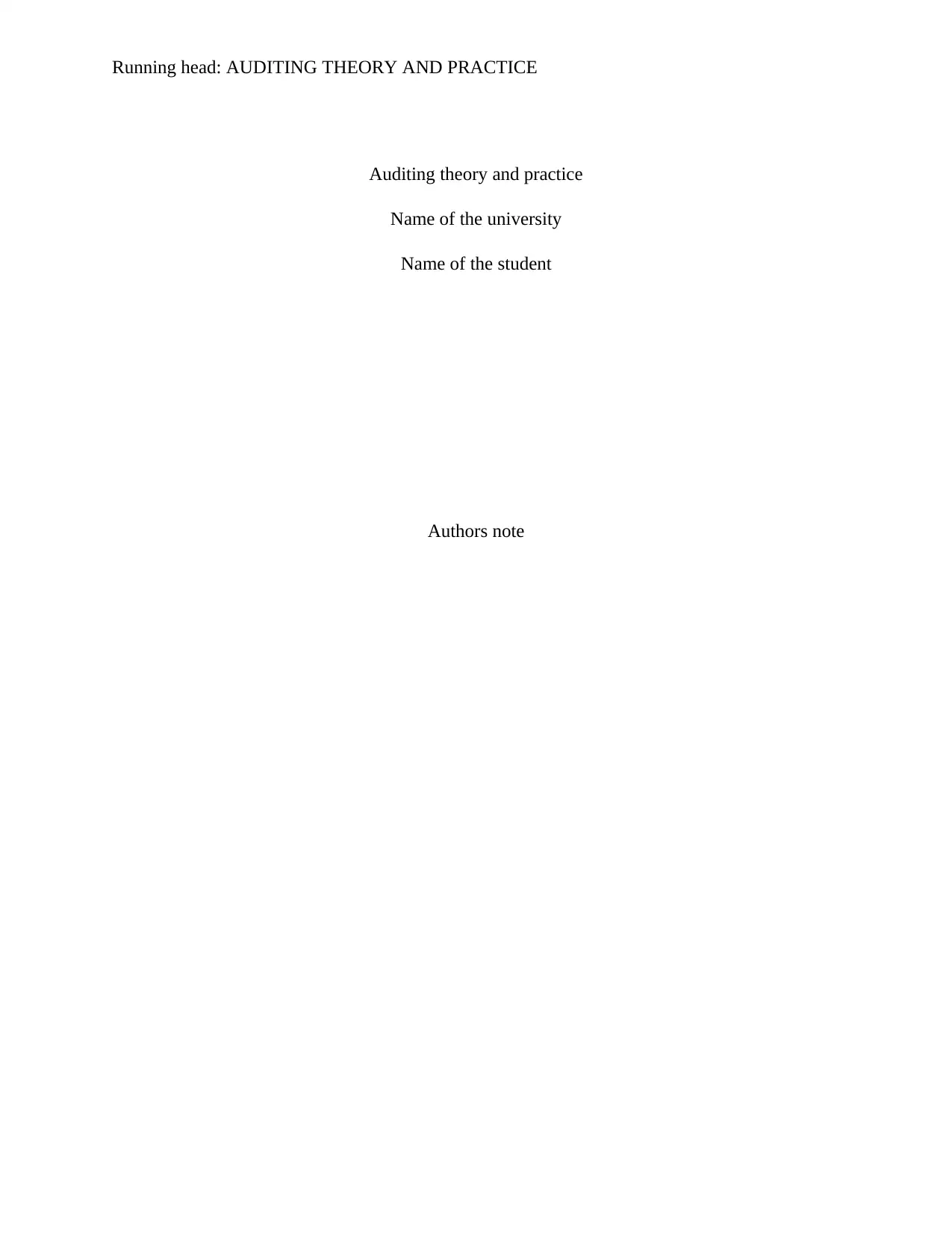
Running head: AUDITING THEORY AND PRACTICE
Auditing theory and practice
Name of the university
Name of the student
Authors note
Auditing theory and practice
Name of the university
Name of the student
Authors note
Paraphrase This Document
Need a fresh take? Get an instant paraphrase of this document with our AI Paraphraser
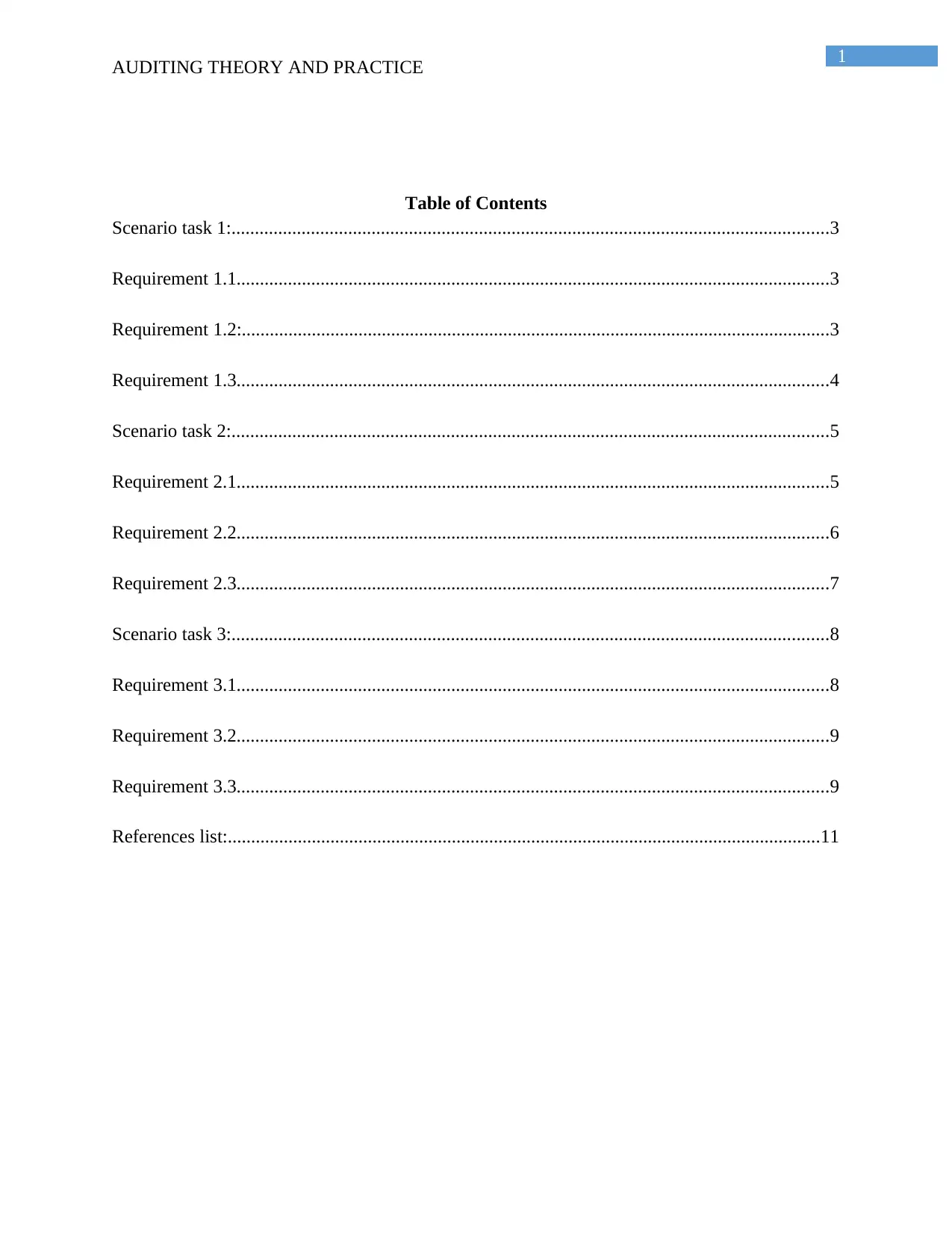
1
AUDITING THEORY AND PRACTICE
Table of Contents
Scenario task 1:................................................................................................................................3
Requirement 1.1...............................................................................................................................3
Requirement 1.2:..............................................................................................................................3
Requirement 1.3...............................................................................................................................4
Scenario task 2:................................................................................................................................5
Requirement 2.1...............................................................................................................................5
Requirement 2.2...............................................................................................................................6
Requirement 2.3...............................................................................................................................7
Scenario task 3:................................................................................................................................8
Requirement 3.1...............................................................................................................................8
Requirement 3.2...............................................................................................................................9
Requirement 3.3...............................................................................................................................9
References list:...............................................................................................................................11
AUDITING THEORY AND PRACTICE
Table of Contents
Scenario task 1:................................................................................................................................3
Requirement 1.1...............................................................................................................................3
Requirement 1.2:..............................................................................................................................3
Requirement 1.3...............................................................................................................................4
Scenario task 2:................................................................................................................................5
Requirement 2.1...............................................................................................................................5
Requirement 2.2...............................................................................................................................6
Requirement 2.3...............................................................................................................................7
Scenario task 3:................................................................................................................................8
Requirement 3.1...............................................................................................................................8
Requirement 3.2...............................................................................................................................9
Requirement 3.3...............................................................................................................................9
References list:...............................................................................................................................11
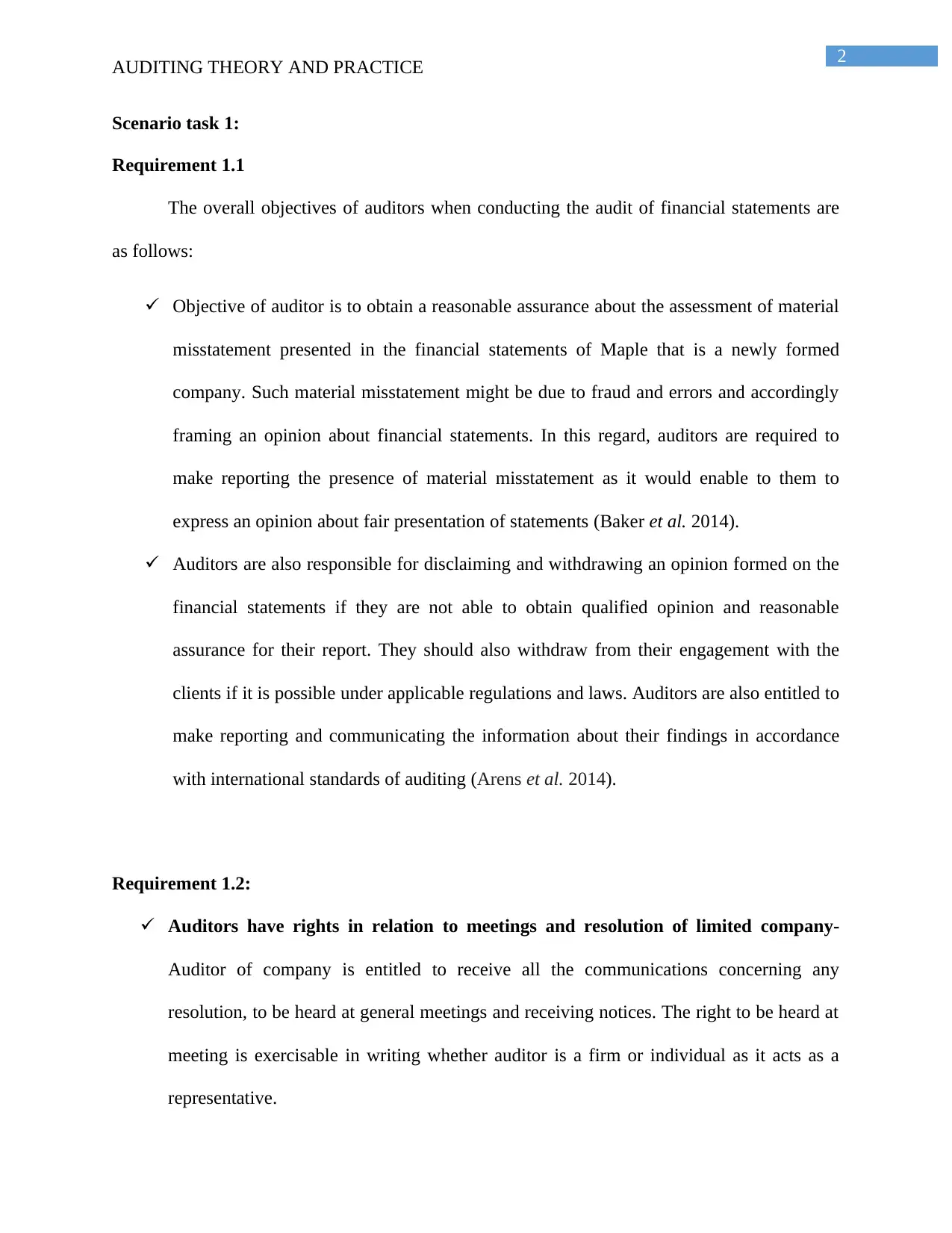
2
AUDITING THEORY AND PRACTICE
Scenario task 1:
Requirement 1.1
The overall objectives of auditors when conducting the audit of financial statements are
as follows:
Objective of auditor is to obtain a reasonable assurance about the assessment of material
misstatement presented in the financial statements of Maple that is a newly formed
company. Such material misstatement might be due to fraud and errors and accordingly
framing an opinion about financial statements. In this regard, auditors are required to
make reporting the presence of material misstatement as it would enable to them to
express an opinion about fair presentation of statements (Baker et al. 2014).
Auditors are also responsible for disclaiming and withdrawing an opinion formed on the
financial statements if they are not able to obtain qualified opinion and reasonable
assurance for their report. They should also withdraw from their engagement with the
clients if it is possible under applicable regulations and laws. Auditors are also entitled to
make reporting and communicating the information about their findings in accordance
with international standards of auditing (Arens et al. 2014).
Requirement 1.2:
Auditors have rights in relation to meetings and resolution of limited company-
Auditor of company is entitled to receive all the communications concerning any
resolution, to be heard at general meetings and receiving notices. The right to be heard at
meeting is exercisable in writing whether auditor is a firm or individual as it acts as a
representative.
AUDITING THEORY AND PRACTICE
Scenario task 1:
Requirement 1.1
The overall objectives of auditors when conducting the audit of financial statements are
as follows:
Objective of auditor is to obtain a reasonable assurance about the assessment of material
misstatement presented in the financial statements of Maple that is a newly formed
company. Such material misstatement might be due to fraud and errors and accordingly
framing an opinion about financial statements. In this regard, auditors are required to
make reporting the presence of material misstatement as it would enable to them to
express an opinion about fair presentation of statements (Baker et al. 2014).
Auditors are also responsible for disclaiming and withdrawing an opinion formed on the
financial statements if they are not able to obtain qualified opinion and reasonable
assurance for their report. They should also withdraw from their engagement with the
clients if it is possible under applicable regulations and laws. Auditors are also entitled to
make reporting and communicating the information about their findings in accordance
with international standards of auditing (Arens et al. 2014).
Requirement 1.2:
Auditors have rights in relation to meetings and resolution of limited company-
Auditor of company is entitled to receive all the communications concerning any
resolution, to be heard at general meetings and receiving notices. The right to be heard at
meeting is exercisable in writing whether auditor is a firm or individual as it acts as a
representative.
⊘ This is a preview!⊘
Do you want full access?
Subscribe today to unlock all pages.

Trusted by 1+ million students worldwide
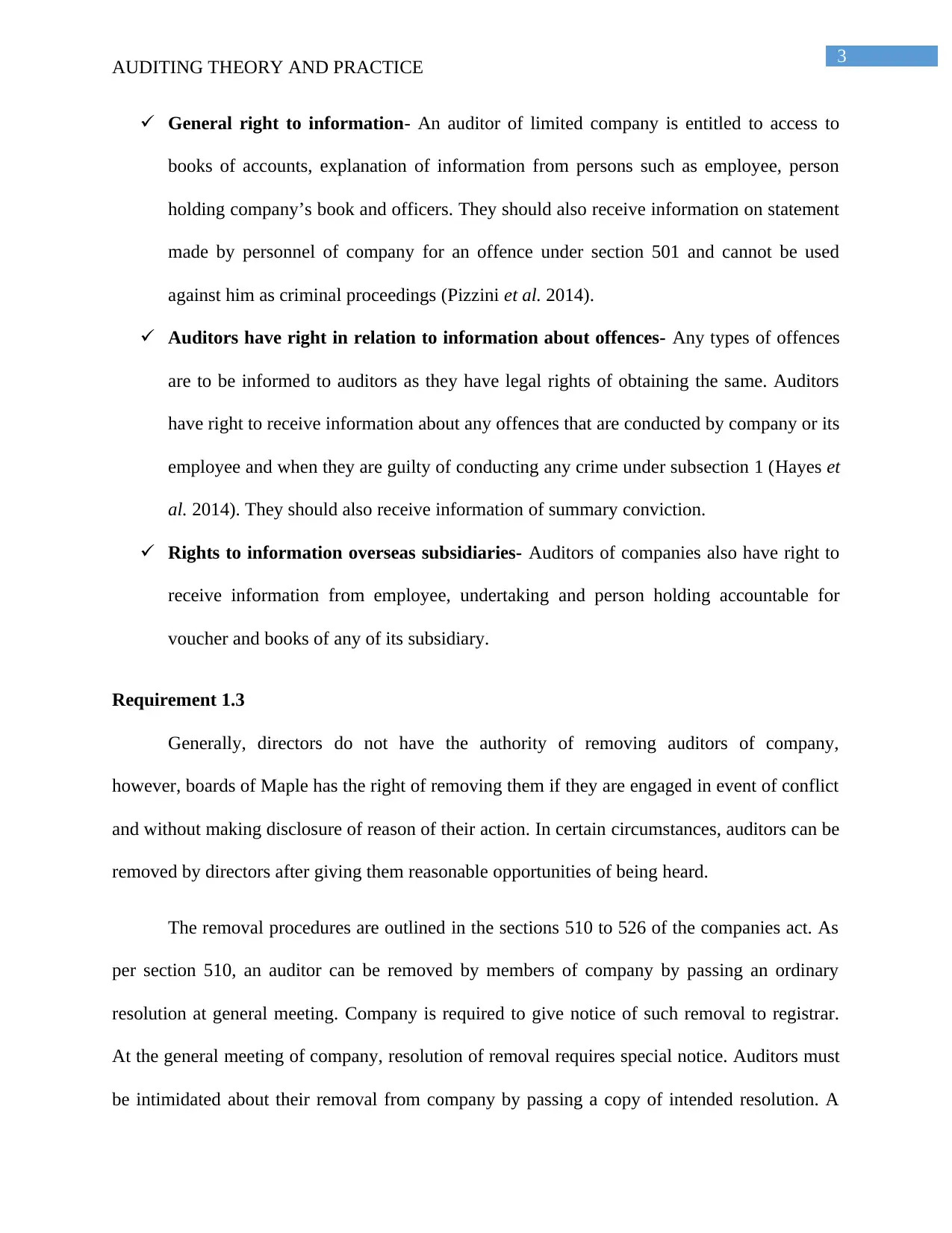
3
AUDITING THEORY AND PRACTICE
General right to information- An auditor of limited company is entitled to access to
books of accounts, explanation of information from persons such as employee, person
holding company’s book and officers. They should also receive information on statement
made by personnel of company for an offence under section 501 and cannot be used
against him as criminal proceedings (Pizzini et al. 2014).
Auditors have right in relation to information about offences- Any types of offences
are to be informed to auditors as they have legal rights of obtaining the same. Auditors
have right to receive information about any offences that are conducted by company or its
employee and when they are guilty of conducting any crime under subsection 1 (Hayes et
al. 2014). They should also receive information of summary conviction.
Rights to information overseas subsidiaries- Auditors of companies also have right to
receive information from employee, undertaking and person holding accountable for
voucher and books of any of its subsidiary.
Requirement 1.3
Generally, directors do not have the authority of removing auditors of company,
however, boards of Maple has the right of removing them if they are engaged in event of conflict
and without making disclosure of reason of their action. In certain circumstances, auditors can be
removed by directors after giving them reasonable opportunities of being heard.
The removal procedures are outlined in the sections 510 to 526 of the companies act. As
per section 510, an auditor can be removed by members of company by passing an ordinary
resolution at general meeting. Company is required to give notice of such removal to registrar.
At the general meeting of company, resolution of removal requires special notice. Auditors must
be intimidated about their removal from company by passing a copy of intended resolution. A
AUDITING THEORY AND PRACTICE
General right to information- An auditor of limited company is entitled to access to
books of accounts, explanation of information from persons such as employee, person
holding company’s book and officers. They should also receive information on statement
made by personnel of company for an offence under section 501 and cannot be used
against him as criminal proceedings (Pizzini et al. 2014).
Auditors have right in relation to information about offences- Any types of offences
are to be informed to auditors as they have legal rights of obtaining the same. Auditors
have right to receive information about any offences that are conducted by company or its
employee and when they are guilty of conducting any crime under subsection 1 (Hayes et
al. 2014). They should also receive information of summary conviction.
Rights to information overseas subsidiaries- Auditors of companies also have right to
receive information from employee, undertaking and person holding accountable for
voucher and books of any of its subsidiary.
Requirement 1.3
Generally, directors do not have the authority of removing auditors of company,
however, boards of Maple has the right of removing them if they are engaged in event of conflict
and without making disclosure of reason of their action. In certain circumstances, auditors can be
removed by directors after giving them reasonable opportunities of being heard.
The removal procedures are outlined in the sections 510 to 526 of the companies act. As
per section 510, an auditor can be removed by members of company by passing an ordinary
resolution at general meeting. Company is required to give notice of such removal to registrar.
At the general meeting of company, resolution of removal requires special notice. Auditors must
be intimidated about their removal from company by passing a copy of intended resolution. A
Paraphrase This Document
Need a fresh take? Get an instant paraphrase of this document with our AI Paraphraser
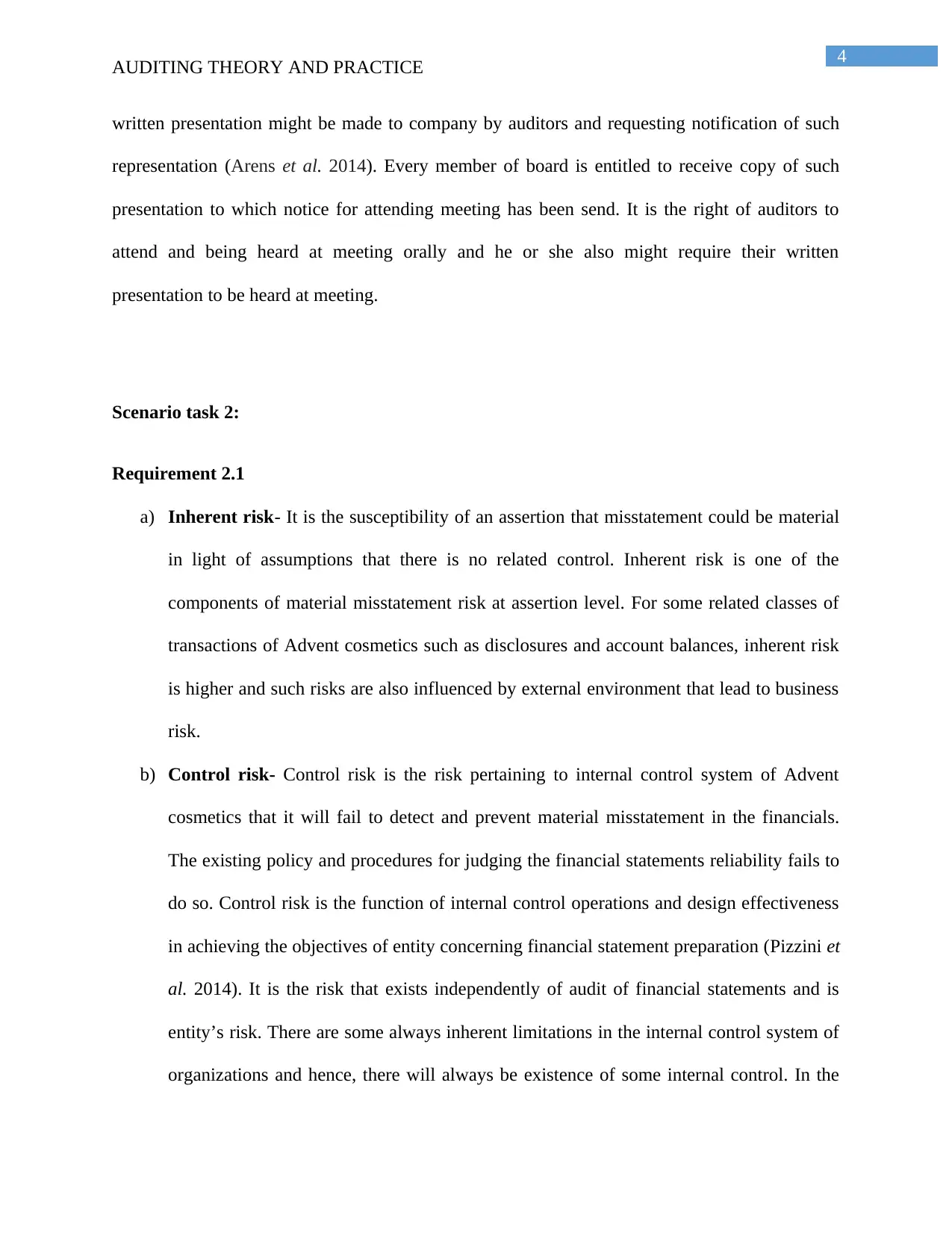
4
AUDITING THEORY AND PRACTICE
written presentation might be made to company by auditors and requesting notification of such
representation (Arens et al. 2014). Every member of board is entitled to receive copy of such
presentation to which notice for attending meeting has been send. It is the right of auditors to
attend and being heard at meeting orally and he or she also might require their written
presentation to be heard at meeting.
Scenario task 2:
Requirement 2.1
a) Inherent risk- It is the susceptibility of an assertion that misstatement could be material
in light of assumptions that there is no related control. Inherent risk is one of the
components of material misstatement risk at assertion level. For some related classes of
transactions of Advent cosmetics such as disclosures and account balances, inherent risk
is higher and such risks are also influenced by external environment that lead to business
risk.
b) Control risk- Control risk is the risk pertaining to internal control system of Advent
cosmetics that it will fail to detect and prevent material misstatement in the financials.
The existing policy and procedures for judging the financial statements reliability fails to
do so. Control risk is the function of internal control operations and design effectiveness
in achieving the objectives of entity concerning financial statement preparation (Pizzini et
al. 2014). It is the risk that exists independently of audit of financial statements and is
entity’s risk. There are some always inherent limitations in the internal control system of
organizations and hence, there will always be existence of some internal control. In the
AUDITING THEORY AND PRACTICE
written presentation might be made to company by auditors and requesting notification of such
representation (Arens et al. 2014). Every member of board is entitled to receive copy of such
presentation to which notice for attending meeting has been send. It is the right of auditors to
attend and being heard at meeting orally and he or she also might require their written
presentation to be heard at meeting.
Scenario task 2:
Requirement 2.1
a) Inherent risk- It is the susceptibility of an assertion that misstatement could be material
in light of assumptions that there is no related control. Inherent risk is one of the
components of material misstatement risk at assertion level. For some related classes of
transactions of Advent cosmetics such as disclosures and account balances, inherent risk
is higher and such risks are also influenced by external environment that lead to business
risk.
b) Control risk- Control risk is the risk pertaining to internal control system of Advent
cosmetics that it will fail to detect and prevent material misstatement in the financials.
The existing policy and procedures for judging the financial statements reliability fails to
do so. Control risk is the function of internal control operations and design effectiveness
in achieving the objectives of entity concerning financial statement preparation (Pizzini et
al. 2014). It is the risk that exists independently of audit of financial statements and is
entity’s risk. There are some always inherent limitations in the internal control system of
organizations and hence, there will always be existence of some internal control. In the
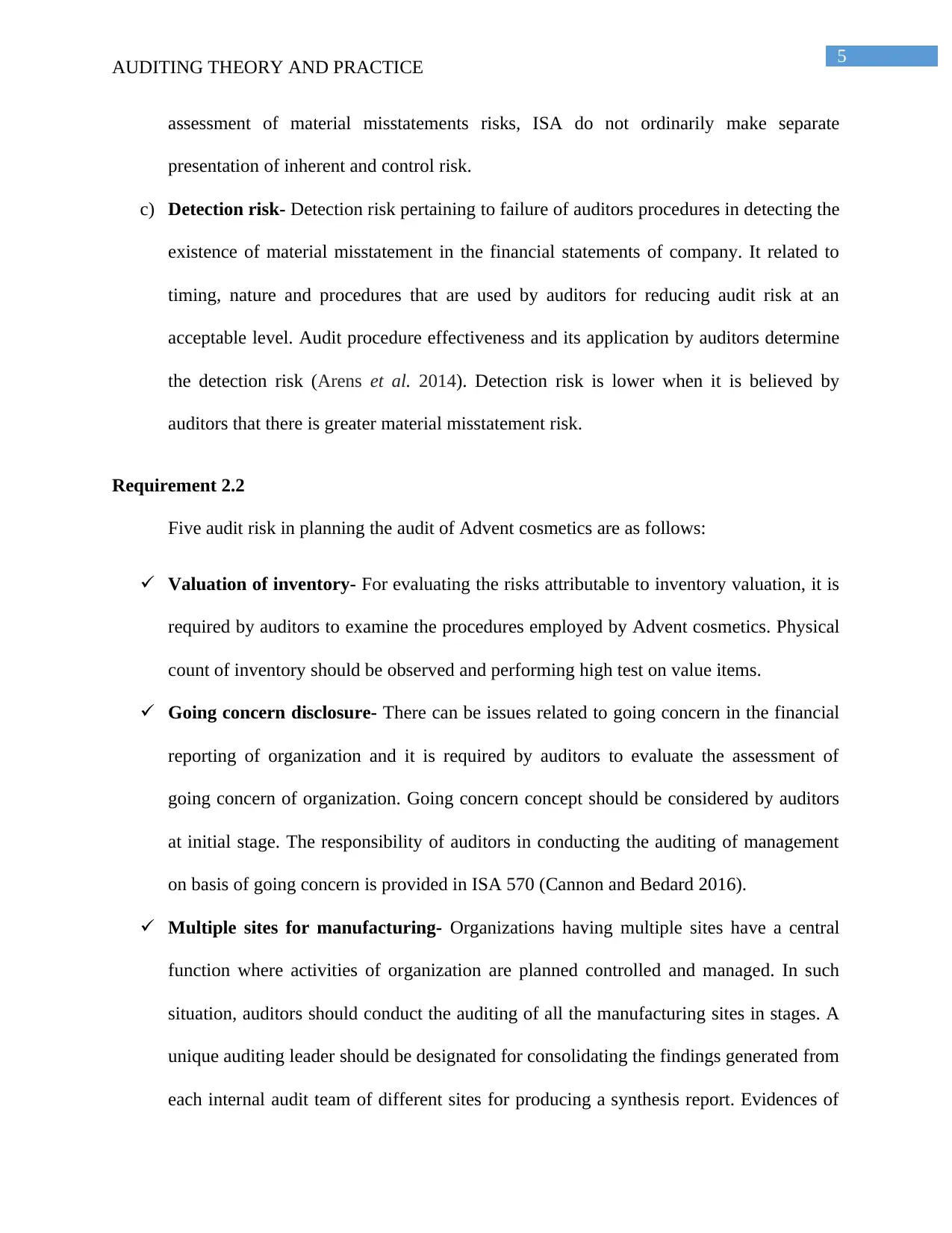
5
AUDITING THEORY AND PRACTICE
assessment of material misstatements risks, ISA do not ordinarily make separate
presentation of inherent and control risk.
c) Detection risk- Detection risk pertaining to failure of auditors procedures in detecting the
existence of material misstatement in the financial statements of company. It related to
timing, nature and procedures that are used by auditors for reducing audit risk at an
acceptable level. Audit procedure effectiveness and its application by auditors determine
the detection risk (Arens et al. 2014). Detection risk is lower when it is believed by
auditors that there is greater material misstatement risk.
Requirement 2.2
Five audit risk in planning the audit of Advent cosmetics are as follows:
Valuation of inventory- For evaluating the risks attributable to inventory valuation, it is
required by auditors to examine the procedures employed by Advent cosmetics. Physical
count of inventory should be observed and performing high test on value items.
Going concern disclosure- There can be issues related to going concern in the financial
reporting of organization and it is required by auditors to evaluate the assessment of
going concern of organization. Going concern concept should be considered by auditors
at initial stage. The responsibility of auditors in conducting the auditing of management
on basis of going concern is provided in ISA 570 (Cannon and Bedard 2016).
Multiple sites for manufacturing- Organizations having multiple sites have a central
function where activities of organization are planned controlled and managed. In such
situation, auditors should conduct the auditing of all the manufacturing sites in stages. A
unique auditing leader should be designated for consolidating the findings generated from
each internal audit team of different sites for producing a synthesis report. Evidences of
AUDITING THEORY AND PRACTICE
assessment of material misstatements risks, ISA do not ordinarily make separate
presentation of inherent and control risk.
c) Detection risk- Detection risk pertaining to failure of auditors procedures in detecting the
existence of material misstatement in the financial statements of company. It related to
timing, nature and procedures that are used by auditors for reducing audit risk at an
acceptable level. Audit procedure effectiveness and its application by auditors determine
the detection risk (Arens et al. 2014). Detection risk is lower when it is believed by
auditors that there is greater material misstatement risk.
Requirement 2.2
Five audit risk in planning the audit of Advent cosmetics are as follows:
Valuation of inventory- For evaluating the risks attributable to inventory valuation, it is
required by auditors to examine the procedures employed by Advent cosmetics. Physical
count of inventory should be observed and performing high test on value items.
Going concern disclosure- There can be issues related to going concern in the financial
reporting of organization and it is required by auditors to evaluate the assessment of
going concern of organization. Going concern concept should be considered by auditors
at initial stage. The responsibility of auditors in conducting the auditing of management
on basis of going concern is provided in ISA 570 (Cannon and Bedard 2016).
Multiple sites for manufacturing- Organizations having multiple sites have a central
function where activities of organization are planned controlled and managed. In such
situation, auditors should conduct the auditing of all the manufacturing sites in stages. A
unique auditing leader should be designated for consolidating the findings generated from
each internal audit team of different sites for producing a synthesis report. Evidences of
⊘ This is a preview!⊘
Do you want full access?
Subscribe today to unlock all pages.

Trusted by 1+ million students worldwide
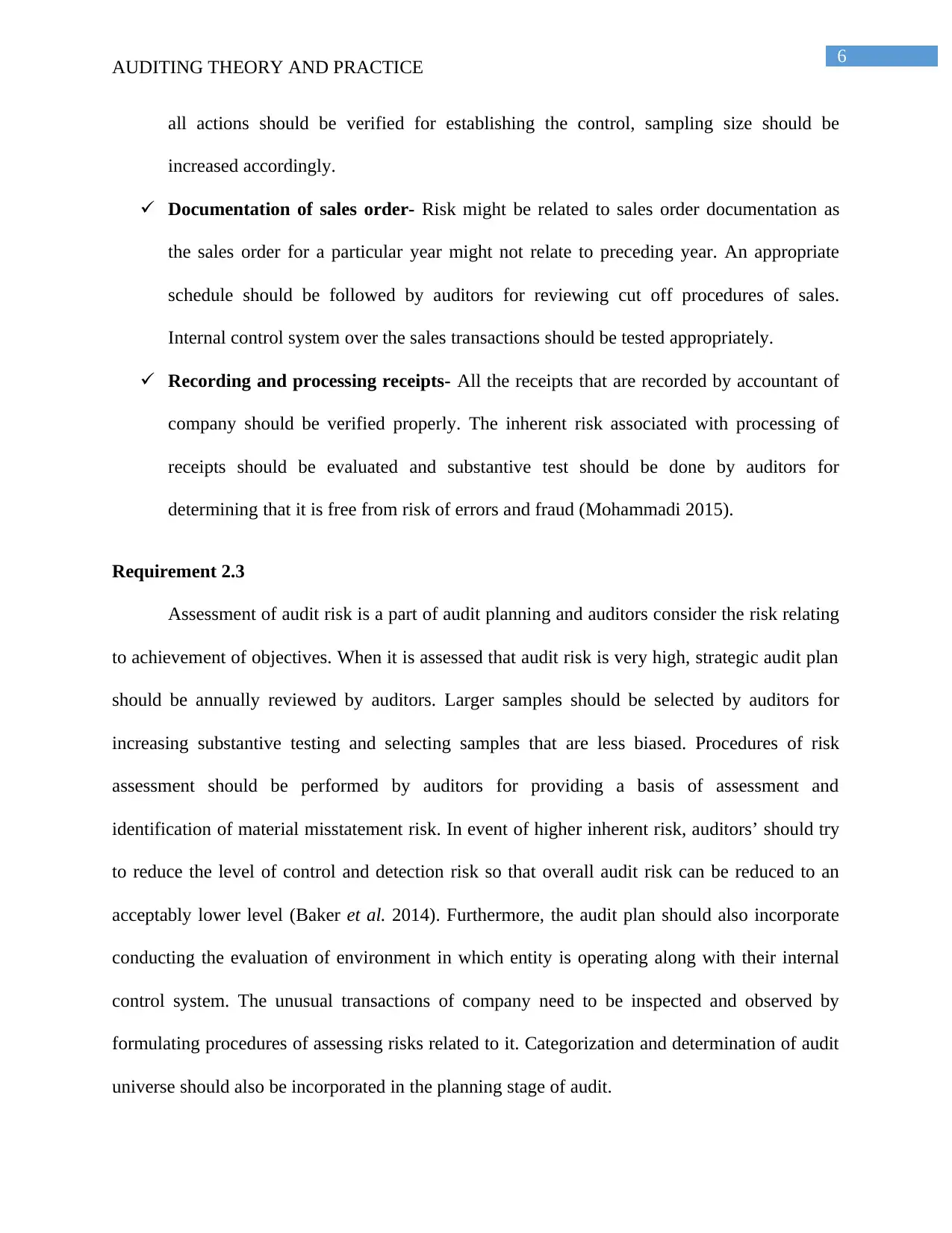
6
AUDITING THEORY AND PRACTICE
all actions should be verified for establishing the control, sampling size should be
increased accordingly.
Documentation of sales order- Risk might be related to sales order documentation as
the sales order for a particular year might not relate to preceding year. An appropriate
schedule should be followed by auditors for reviewing cut off procedures of sales.
Internal control system over the sales transactions should be tested appropriately.
Recording and processing receipts- All the receipts that are recorded by accountant of
company should be verified properly. The inherent risk associated with processing of
receipts should be evaluated and substantive test should be done by auditors for
determining that it is free from risk of errors and fraud (Mohammadi 2015).
Requirement 2.3
Assessment of audit risk is a part of audit planning and auditors consider the risk relating
to achievement of objectives. When it is assessed that audit risk is very high, strategic audit plan
should be annually reviewed by auditors. Larger samples should be selected by auditors for
increasing substantive testing and selecting samples that are less biased. Procedures of risk
assessment should be performed by auditors for providing a basis of assessment and
identification of material misstatement risk. In event of higher inherent risk, auditors’ should try
to reduce the level of control and detection risk so that overall audit risk can be reduced to an
acceptably lower level (Baker et al. 2014). Furthermore, the audit plan should also incorporate
conducting the evaluation of environment in which entity is operating along with their internal
control system. The unusual transactions of company need to be inspected and observed by
formulating procedures of assessing risks related to it. Categorization and determination of audit
universe should also be incorporated in the planning stage of audit.
AUDITING THEORY AND PRACTICE
all actions should be verified for establishing the control, sampling size should be
increased accordingly.
Documentation of sales order- Risk might be related to sales order documentation as
the sales order for a particular year might not relate to preceding year. An appropriate
schedule should be followed by auditors for reviewing cut off procedures of sales.
Internal control system over the sales transactions should be tested appropriately.
Recording and processing receipts- All the receipts that are recorded by accountant of
company should be verified properly. The inherent risk associated with processing of
receipts should be evaluated and substantive test should be done by auditors for
determining that it is free from risk of errors and fraud (Mohammadi 2015).
Requirement 2.3
Assessment of audit risk is a part of audit planning and auditors consider the risk relating
to achievement of objectives. When it is assessed that audit risk is very high, strategic audit plan
should be annually reviewed by auditors. Larger samples should be selected by auditors for
increasing substantive testing and selecting samples that are less biased. Procedures of risk
assessment should be performed by auditors for providing a basis of assessment and
identification of material misstatement risk. In event of higher inherent risk, auditors’ should try
to reduce the level of control and detection risk so that overall audit risk can be reduced to an
acceptably lower level (Baker et al. 2014). Furthermore, the audit plan should also incorporate
conducting the evaluation of environment in which entity is operating along with their internal
control system. The unusual transactions of company need to be inspected and observed by
formulating procedures of assessing risks related to it. Categorization and determination of audit
universe should also be incorporated in the planning stage of audit.
Paraphrase This Document
Need a fresh take? Get an instant paraphrase of this document with our AI Paraphraser
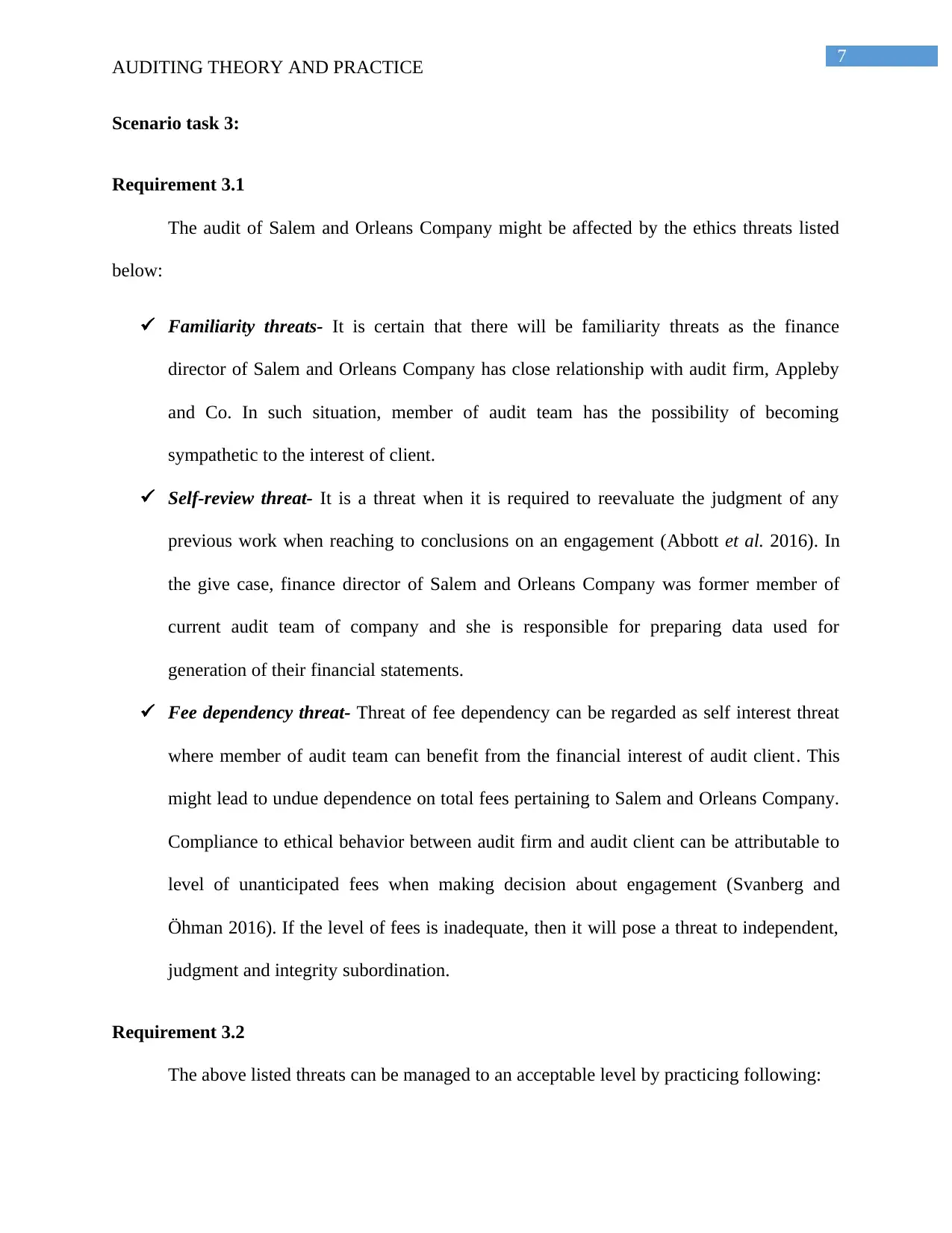
7
AUDITING THEORY AND PRACTICE
Scenario task 3:
Requirement 3.1
The audit of Salem and Orleans Company might be affected by the ethics threats listed
below:
Familiarity threats- It is certain that there will be familiarity threats as the finance
director of Salem and Orleans Company has close relationship with audit firm, Appleby
and Co. In such situation, member of audit team has the possibility of becoming
sympathetic to the interest of client.
Self-review threat- It is a threat when it is required to reevaluate the judgment of any
previous work when reaching to conclusions on an engagement (Abbott et al. 2016). In
the give case, finance director of Salem and Orleans Company was former member of
current audit team of company and she is responsible for preparing data used for
generation of their financial statements.
Fee dependency threat- Threat of fee dependency can be regarded as self interest threat
where member of audit team can benefit from the financial interest of audit client. This
might lead to undue dependence on total fees pertaining to Salem and Orleans Company.
Compliance to ethical behavior between audit firm and audit client can be attributable to
level of unanticipated fees when making decision about engagement (Svanberg and
Öhman 2016). If the level of fees is inadequate, then it will pose a threat to independent,
judgment and integrity subordination.
Requirement 3.2
The above listed threats can be managed to an acceptable level by practicing following:
AUDITING THEORY AND PRACTICE
Scenario task 3:
Requirement 3.1
The audit of Salem and Orleans Company might be affected by the ethics threats listed
below:
Familiarity threats- It is certain that there will be familiarity threats as the finance
director of Salem and Orleans Company has close relationship with audit firm, Appleby
and Co. In such situation, member of audit team has the possibility of becoming
sympathetic to the interest of client.
Self-review threat- It is a threat when it is required to reevaluate the judgment of any
previous work when reaching to conclusions on an engagement (Abbott et al. 2016). In
the give case, finance director of Salem and Orleans Company was former member of
current audit team of company and she is responsible for preparing data used for
generation of their financial statements.
Fee dependency threat- Threat of fee dependency can be regarded as self interest threat
where member of audit team can benefit from the financial interest of audit client. This
might lead to undue dependence on total fees pertaining to Salem and Orleans Company.
Compliance to ethical behavior between audit firm and audit client can be attributable to
level of unanticipated fees when making decision about engagement (Svanberg and
Öhman 2016). If the level of fees is inadequate, then it will pose a threat to independent,
judgment and integrity subordination.
Requirement 3.2
The above listed threats can be managed to an acceptable level by practicing following:
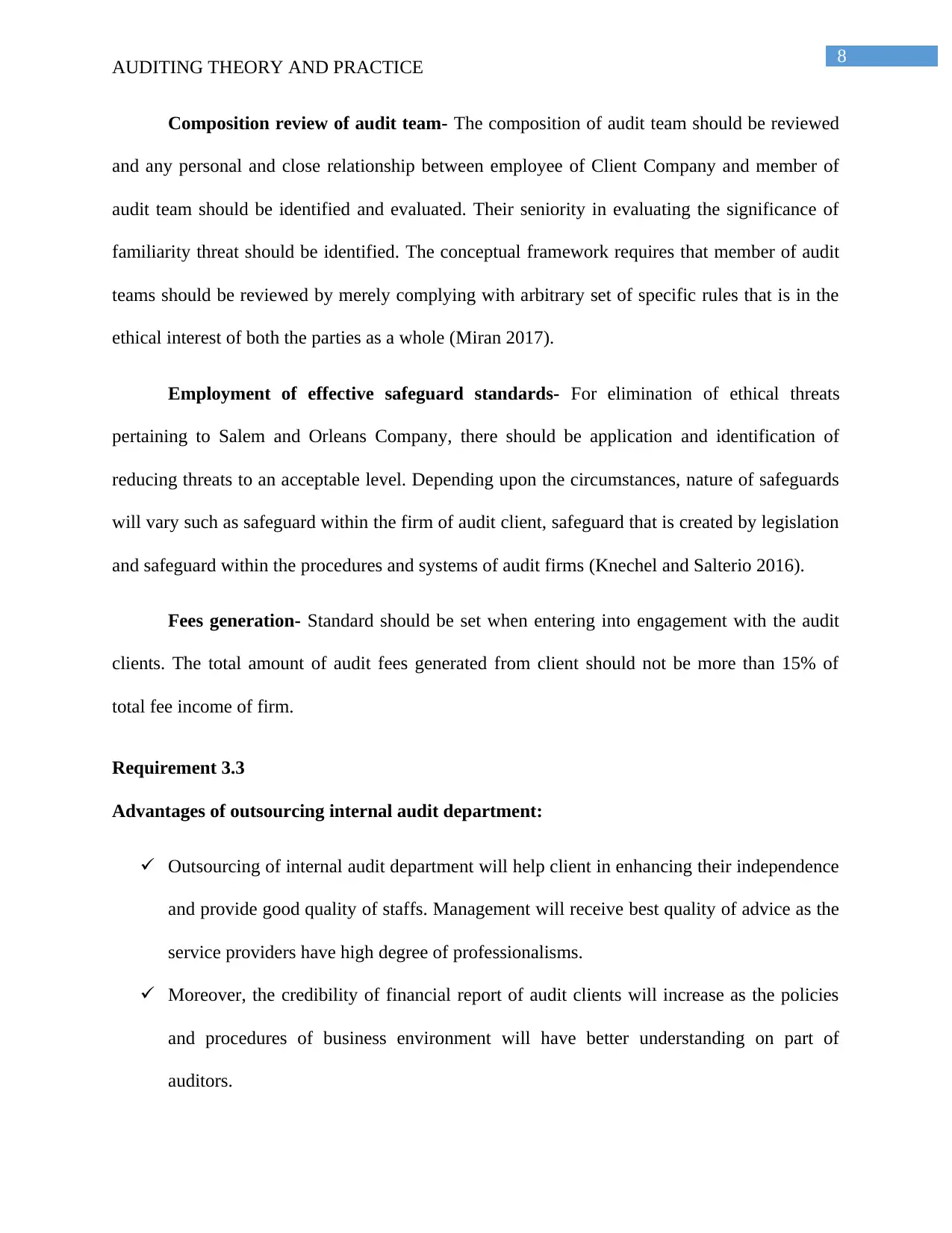
8
AUDITING THEORY AND PRACTICE
Composition review of audit team- The composition of audit team should be reviewed
and any personal and close relationship between employee of Client Company and member of
audit team should be identified and evaluated. Their seniority in evaluating the significance of
familiarity threat should be identified. The conceptual framework requires that member of audit
teams should be reviewed by merely complying with arbitrary set of specific rules that is in the
ethical interest of both the parties as a whole (Miran 2017).
Employment of effective safeguard standards- For elimination of ethical threats
pertaining to Salem and Orleans Company, there should be application and identification of
reducing threats to an acceptable level. Depending upon the circumstances, nature of safeguards
will vary such as safeguard within the firm of audit client, safeguard that is created by legislation
and safeguard within the procedures and systems of audit firms (Knechel and Salterio 2016).
Fees generation- Standard should be set when entering into engagement with the audit
clients. The total amount of audit fees generated from client should not be more than 15% of
total fee income of firm.
Requirement 3.3
Advantages of outsourcing internal audit department:
Outsourcing of internal audit department will help client in enhancing their independence
and provide good quality of staffs. Management will receive best quality of advice as the
service providers have high degree of professionalisms.
Moreover, the credibility of financial report of audit clients will increase as the policies
and procedures of business environment will have better understanding on part of
auditors.
AUDITING THEORY AND PRACTICE
Composition review of audit team- The composition of audit team should be reviewed
and any personal and close relationship between employee of Client Company and member of
audit team should be identified and evaluated. Their seniority in evaluating the significance of
familiarity threat should be identified. The conceptual framework requires that member of audit
teams should be reviewed by merely complying with arbitrary set of specific rules that is in the
ethical interest of both the parties as a whole (Miran 2017).
Employment of effective safeguard standards- For elimination of ethical threats
pertaining to Salem and Orleans Company, there should be application and identification of
reducing threats to an acceptable level. Depending upon the circumstances, nature of safeguards
will vary such as safeguard within the firm of audit client, safeguard that is created by legislation
and safeguard within the procedures and systems of audit firms (Knechel and Salterio 2016).
Fees generation- Standard should be set when entering into engagement with the audit
clients. The total amount of audit fees generated from client should not be more than 15% of
total fee income of firm.
Requirement 3.3
Advantages of outsourcing internal audit department:
Outsourcing of internal audit department will help client in enhancing their independence
and provide good quality of staffs. Management will receive best quality of advice as the
service providers have high degree of professionalisms.
Moreover, the credibility of financial report of audit clients will increase as the policies
and procedures of business environment will have better understanding on part of
auditors.
⊘ This is a preview!⊘
Do you want full access?
Subscribe today to unlock all pages.

Trusted by 1+ million students worldwide
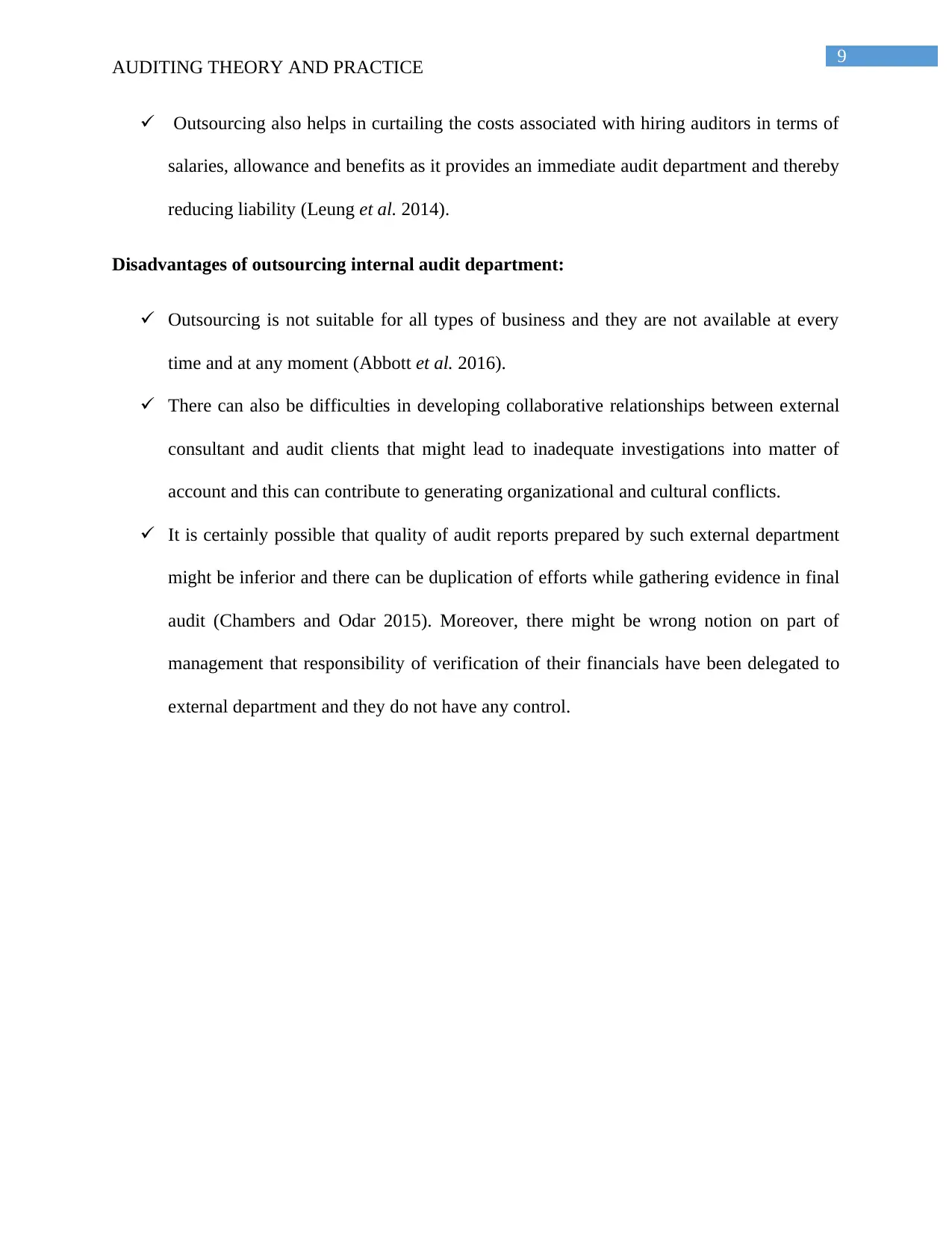
9
AUDITING THEORY AND PRACTICE
Outsourcing also helps in curtailing the costs associated with hiring auditors in terms of
salaries, allowance and benefits as it provides an immediate audit department and thereby
reducing liability (Leung et al. 2014).
Disadvantages of outsourcing internal audit department:
Outsourcing is not suitable for all types of business and they are not available at every
time and at any moment (Abbott et al. 2016).
There can also be difficulties in developing collaborative relationships between external
consultant and audit clients that might lead to inadequate investigations into matter of
account and this can contribute to generating organizational and cultural conflicts.
It is certainly possible that quality of audit reports prepared by such external department
might be inferior and there can be duplication of efforts while gathering evidence in final
audit (Chambers and Odar 2015). Moreover, there might be wrong notion on part of
management that responsibility of verification of their financials have been delegated to
external department and they do not have any control.
AUDITING THEORY AND PRACTICE
Outsourcing also helps in curtailing the costs associated with hiring auditors in terms of
salaries, allowance and benefits as it provides an immediate audit department and thereby
reducing liability (Leung et al. 2014).
Disadvantages of outsourcing internal audit department:
Outsourcing is not suitable for all types of business and they are not available at every
time and at any moment (Abbott et al. 2016).
There can also be difficulties in developing collaborative relationships between external
consultant and audit clients that might lead to inadequate investigations into matter of
account and this can contribute to generating organizational and cultural conflicts.
It is certainly possible that quality of audit reports prepared by such external department
might be inferior and there can be duplication of efforts while gathering evidence in final
audit (Chambers and Odar 2015). Moreover, there might be wrong notion on part of
management that responsibility of verification of their financials have been delegated to
external department and they do not have any control.
Paraphrase This Document
Need a fresh take? Get an instant paraphrase of this document with our AI Paraphraser
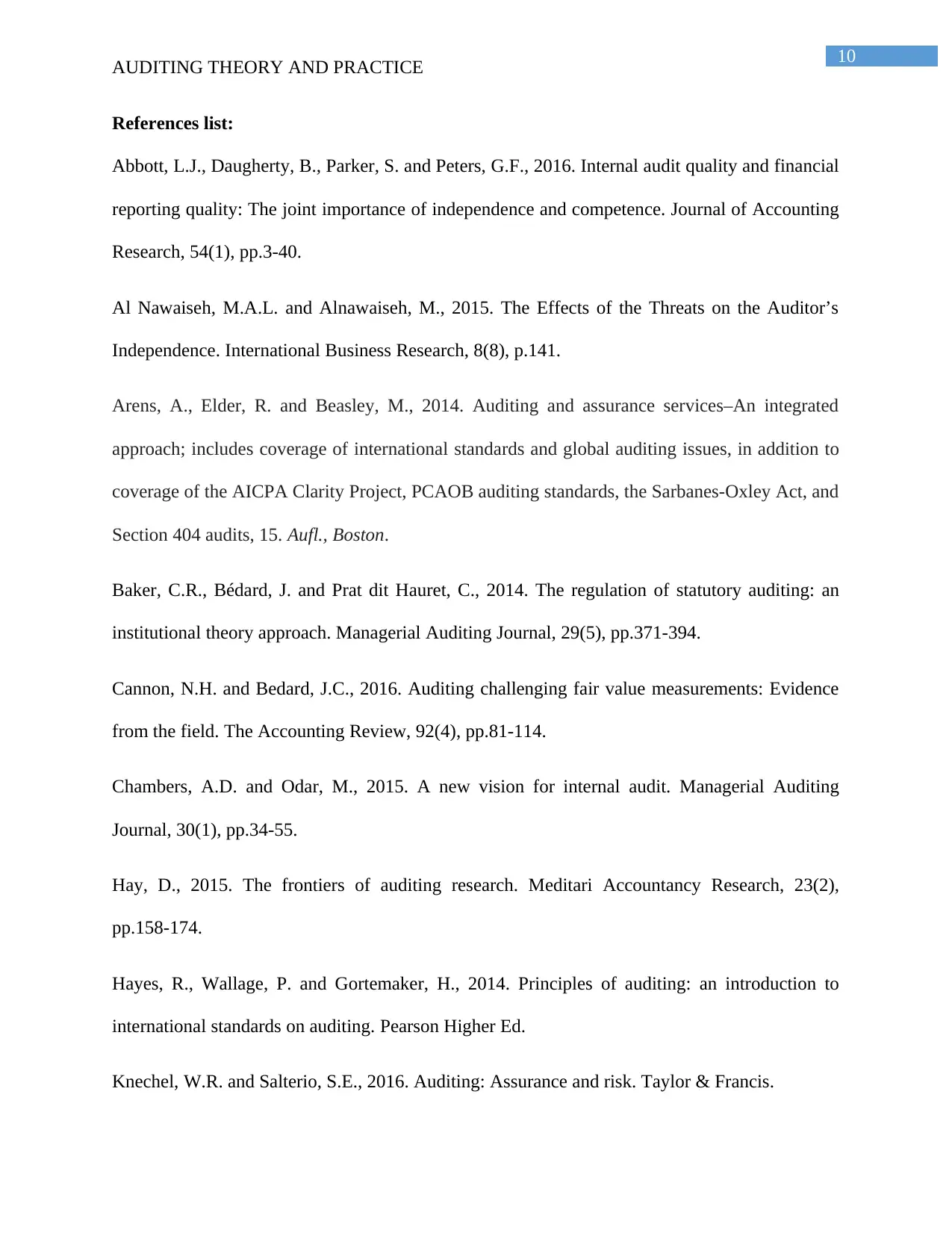
10
AUDITING THEORY AND PRACTICE
References list:
Abbott, L.J., Daugherty, B., Parker, S. and Peters, G.F., 2016. Internal audit quality and financial
reporting quality: The joint importance of independence and competence. Journal of Accounting
Research, 54(1), pp.3-40.
Al Nawaiseh, M.A.L. and Alnawaiseh, M., 2015. The Effects of the Threats on the Auditor’s
Independence. International Business Research, 8(8), p.141.
Arens, A., Elder, R. and Beasley, M., 2014. Auditing and assurance services–An integrated
approach; includes coverage of international standards and global auditing issues, in addition to
coverage of the AICPA Clarity Project, PCAOB auditing standards, the Sarbanes-Oxley Act, and
Section 404 audits, 15. Aufl., Boston.
Baker, C.R., Bédard, J. and Prat dit Hauret, C., 2014. The regulation of statutory auditing: an
institutional theory approach. Managerial Auditing Journal, 29(5), pp.371-394.
Cannon, N.H. and Bedard, J.C., 2016. Auditing challenging fair value measurements: Evidence
from the field. The Accounting Review, 92(4), pp.81-114.
Chambers, A.D. and Odar, M., 2015. A new vision for internal audit. Managerial Auditing
Journal, 30(1), pp.34-55.
Hay, D., 2015. The frontiers of auditing research. Meditari Accountancy Research, 23(2),
pp.158-174.
Hayes, R., Wallage, P. and Gortemaker, H., 2014. Principles of auditing: an introduction to
international standards on auditing. Pearson Higher Ed.
Knechel, W.R. and Salterio, S.E., 2016. Auditing: Assurance and risk. Taylor & Francis.
AUDITING THEORY AND PRACTICE
References list:
Abbott, L.J., Daugherty, B., Parker, S. and Peters, G.F., 2016. Internal audit quality and financial
reporting quality: The joint importance of independence and competence. Journal of Accounting
Research, 54(1), pp.3-40.
Al Nawaiseh, M.A.L. and Alnawaiseh, M., 2015. The Effects of the Threats on the Auditor’s
Independence. International Business Research, 8(8), p.141.
Arens, A., Elder, R. and Beasley, M., 2014. Auditing and assurance services–An integrated
approach; includes coverage of international standards and global auditing issues, in addition to
coverage of the AICPA Clarity Project, PCAOB auditing standards, the Sarbanes-Oxley Act, and
Section 404 audits, 15. Aufl., Boston.
Baker, C.R., Bédard, J. and Prat dit Hauret, C., 2014. The regulation of statutory auditing: an
institutional theory approach. Managerial Auditing Journal, 29(5), pp.371-394.
Cannon, N.H. and Bedard, J.C., 2016. Auditing challenging fair value measurements: Evidence
from the field. The Accounting Review, 92(4), pp.81-114.
Chambers, A.D. and Odar, M., 2015. A new vision for internal audit. Managerial Auditing
Journal, 30(1), pp.34-55.
Hay, D., 2015. The frontiers of auditing research. Meditari Accountancy Research, 23(2),
pp.158-174.
Hayes, R., Wallage, P. and Gortemaker, H., 2014. Principles of auditing: an introduction to
international standards on auditing. Pearson Higher Ed.
Knechel, W.R. and Salterio, S.E., 2016. Auditing: Assurance and risk. Taylor & Francis.
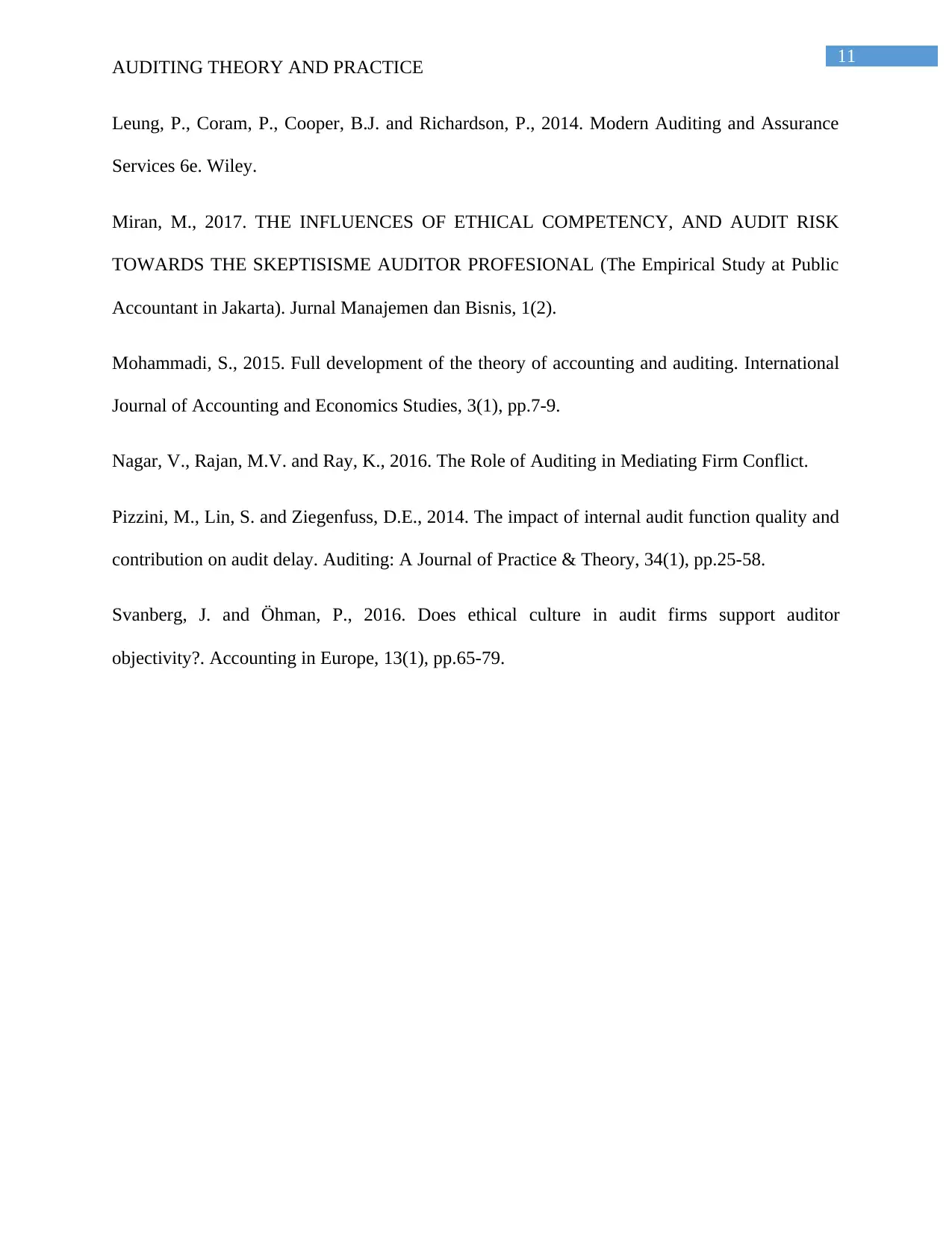
11
AUDITING THEORY AND PRACTICE
Leung, P., Coram, P., Cooper, B.J. and Richardson, P., 2014. Modern Auditing and Assurance
Services 6e. Wiley.
Miran, M., 2017. THE INFLUENCES OF ETHICAL COMPETENCY, AND AUDIT RISK
TOWARDS THE SKEPTISISME AUDITOR PROFESIONAL (The Empirical Study at Public
Accountant in Jakarta). Jurnal Manajemen dan Bisnis, 1(2).
Mohammadi, S., 2015. Full development of the theory of accounting and auditing. International
Journal of Accounting and Economics Studies, 3(1), pp.7-9.
Nagar, V., Rajan, M.V. and Ray, K., 2016. The Role of Auditing in Mediating Firm Conflict.
Pizzini, M., Lin, S. and Ziegenfuss, D.E., 2014. The impact of internal audit function quality and
contribution on audit delay. Auditing: A Journal of Practice & Theory, 34(1), pp.25-58.
Svanberg, J. and Öhman, P., 2016. Does ethical culture in audit firms support auditor
objectivity?. Accounting in Europe, 13(1), pp.65-79.
AUDITING THEORY AND PRACTICE
Leung, P., Coram, P., Cooper, B.J. and Richardson, P., 2014. Modern Auditing and Assurance
Services 6e. Wiley.
Miran, M., 2017. THE INFLUENCES OF ETHICAL COMPETENCY, AND AUDIT RISK
TOWARDS THE SKEPTISISME AUDITOR PROFESIONAL (The Empirical Study at Public
Accountant in Jakarta). Jurnal Manajemen dan Bisnis, 1(2).
Mohammadi, S., 2015. Full development of the theory of accounting and auditing. International
Journal of Accounting and Economics Studies, 3(1), pp.7-9.
Nagar, V., Rajan, M.V. and Ray, K., 2016. The Role of Auditing in Mediating Firm Conflict.
Pizzini, M., Lin, S. and Ziegenfuss, D.E., 2014. The impact of internal audit function quality and
contribution on audit delay. Auditing: A Journal of Practice & Theory, 34(1), pp.25-58.
Svanberg, J. and Öhman, P., 2016. Does ethical culture in audit firms support auditor
objectivity?. Accounting in Europe, 13(1), pp.65-79.
⊘ This is a preview!⊘
Do you want full access?
Subscribe today to unlock all pages.

Trusted by 1+ million students worldwide
1 out of 13
Related Documents
Your All-in-One AI-Powered Toolkit for Academic Success.
+13062052269
info@desklib.com
Available 24*7 on WhatsApp / Email
![[object Object]](/_next/static/media/star-bottom.7253800d.svg)
Unlock your academic potential
Copyright © 2020–2025 A2Z Services. All Rights Reserved. Developed and managed by ZUCOL.





